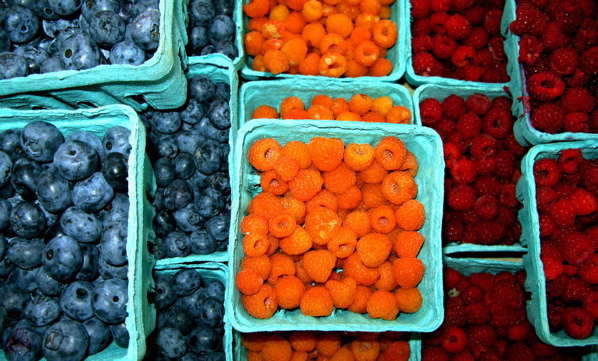One of my best teachers from nutrition school has a saying: “Where everyone thinks alike, no one thinks at all.”
Though generally accepted, I am not in support of Canada’s Food Guide, or the American Food Pyramid, or the whole Five-A-Day campaign that was all over the UK when I was there recently. I am really not for any generalizations around diet and I don’t think we should have to consult a chart to determine what we should be eating.
I do agree that there is big, fat, massive confusion over what is healthy, what we should eat, what we should avoid and what nutrient of the day is going to save us from our own bad habits. To follow a guide that first came out about 50 years ago and is a product of politics, lobby groups, and food industries’ best interests has done little for our health.
We have the four food groups: dairy, meat, fruit and veg, and grains.
Does this seem odd to anyone or have we just come to accept this as the way food gets grouped? Are we all thinking alike? Is dairy a fat or a protein? Are nuts a grain, a meat or a vegetable? What about sugar? What food group do we put sugar in? We do get nearly 10% of our calories from sugar. Shouldn’t sugar have a group too? Why is fish with meat? Why is fruit with vegetables? And again – what about nuts, seeds and lentils? Where do they fit in?
These generally accepted, mass market approved nutritional guidelines are recommended by doctors and dietitians, taught in school, and fully supported (and sponsored) by the milk board, cow farmers, grain farmers, and food industrialists. But do they work? Are we healthier now than we were 50 years ago, before we had these guidelines to follow? I am bringing this up now as in the last 24 hours or so, I have been challenged on the whole food nutrition I am promoting, practicing and teaching. I have been told that if I want to be successful in the nutrition field, I need to start with a generally accepted understanding of nutrition.
The challenge I have is that these guides are generally accepted, but they are not nutrition. They place equal value on a bagel and a bowl of brown rice, a glass of skim milk and a serving of fresh vegetables. We are warned not to eat too many nuts or avocados because they are higher in fat content but are encouraged to go with margarine and fat-free cheese which have nothing of nutritional value (and are gross).
The food we eat does one of two things to our body. It will build our health or build our disease. Since we all like our guides and given all the marketing around food, we could all use a little honest direction. I present to you HonestFoodGuide.org‘s Honest Food Guide.
What are your thoughts on government directed food guides?
Meghan Telpner, Certified Nutritionist and creator of the blog Making Love In The Kitchen, delivers a refreshingly realistic approach to nutrition and healthy living. Based in Toronto, Meghan is the director of The Love In The Kitchen Academy cooking school as well as Nourish Your Soul Holidays, leading healthy living retreats worldwide.
Image courtesy of Laura Padgett.



All I can say is – “Eat Right 4 Your Blood Type” – uncannily accurate. I’m a type ‘O’, the hunter, the meat and potatoes type. Incidentally, I can’t eat wheat or milk due to a developped gluten and casein intollerance. Thanks to marketing? Pollutants? Food refinement and engineering? Personal genetics? Misinformation? Probably a mix of all of the above.
I have always believed that food guides are for the birds – literally!!!
Dear Meghan,
Thank you for presenting an alternative guide to consider.
In your article you questioned the grouping of fish with meat. The Honest Food Guide makes no mention of fish or even chicken or other types of meat besides red. What is your opinion of fish and chicken? Also, are all red meats equal?
I have come to believe that staying away from any food that comes in a box is generally a good idea, as is sticking to the outside aisles of the grocery store, except for maybe the baking aisle – the oatmeal chocolate chip cookie mix is just too good!
Government food guides are fed by commercial interests. Follow them only if you believe that the politicians do not lie for financial gain at our expense.
The thing about nutrition is it’s far too complex to generalize, either as four food groups or as food that builds health or builds disease. Any nutrition system that is understandable by the general public will necessarily be simplified. I think the system of four food groups, with suggested servings, does a pretty good job of providing a reasonably balanced, healthy diet.
The thing about food guides is that they’ll inevitably be pushed by the commercial interest that stand to benefit. Sure the dairy industry will fight to keep dairy as food group, just like the whole/organic food industry will push and market the honest food guide (calling it “honest” being a loaded marketing term if I’ve ever heard one). Any food purchase is going to benefit a business, whether big or small. To argue that we should link the nutritional value of food we eat to the size of the industry that produces it is dishonest. Soy beans are a huge industry yet they’re still nutritious.
I agree with most of it but it’s basically a vegan diet other than fish on the health side. A pretty big omission is all other meats other than red meat and fish. Where is chicken for example? Also, are eggs lumped under the general dairy category of the disease side? I think it’s arguable that they belong on the health side. 95% of it is bang on though.